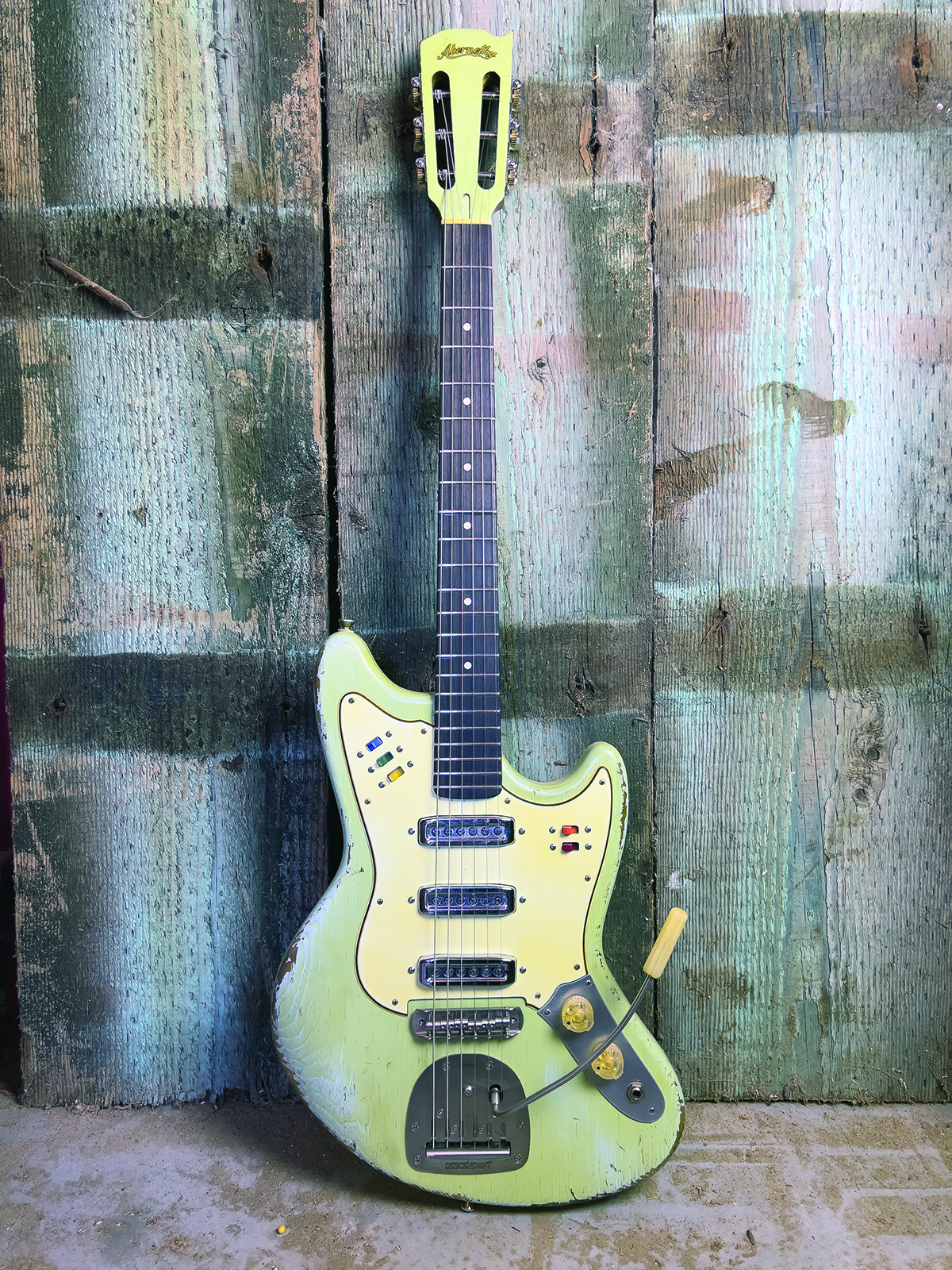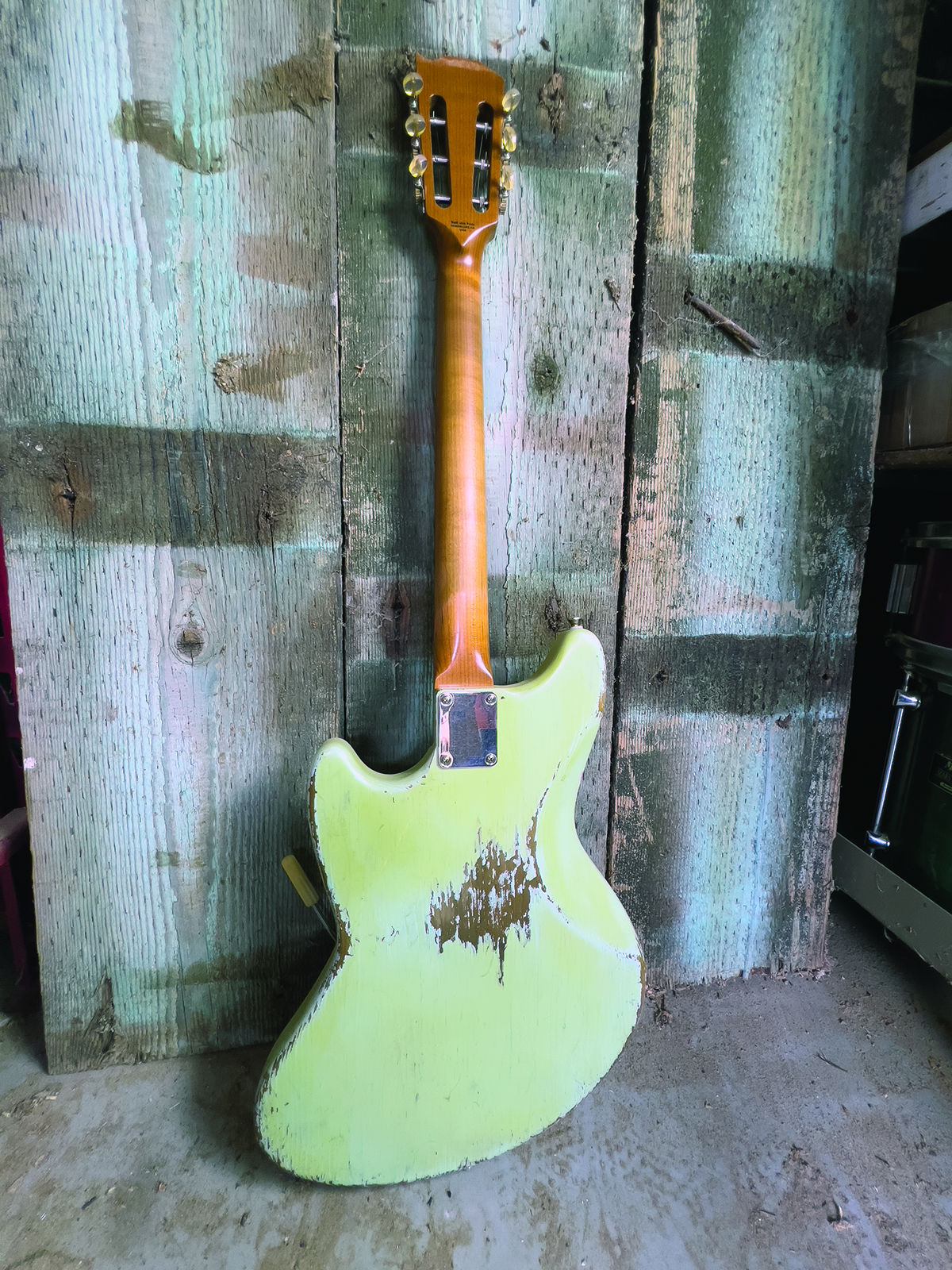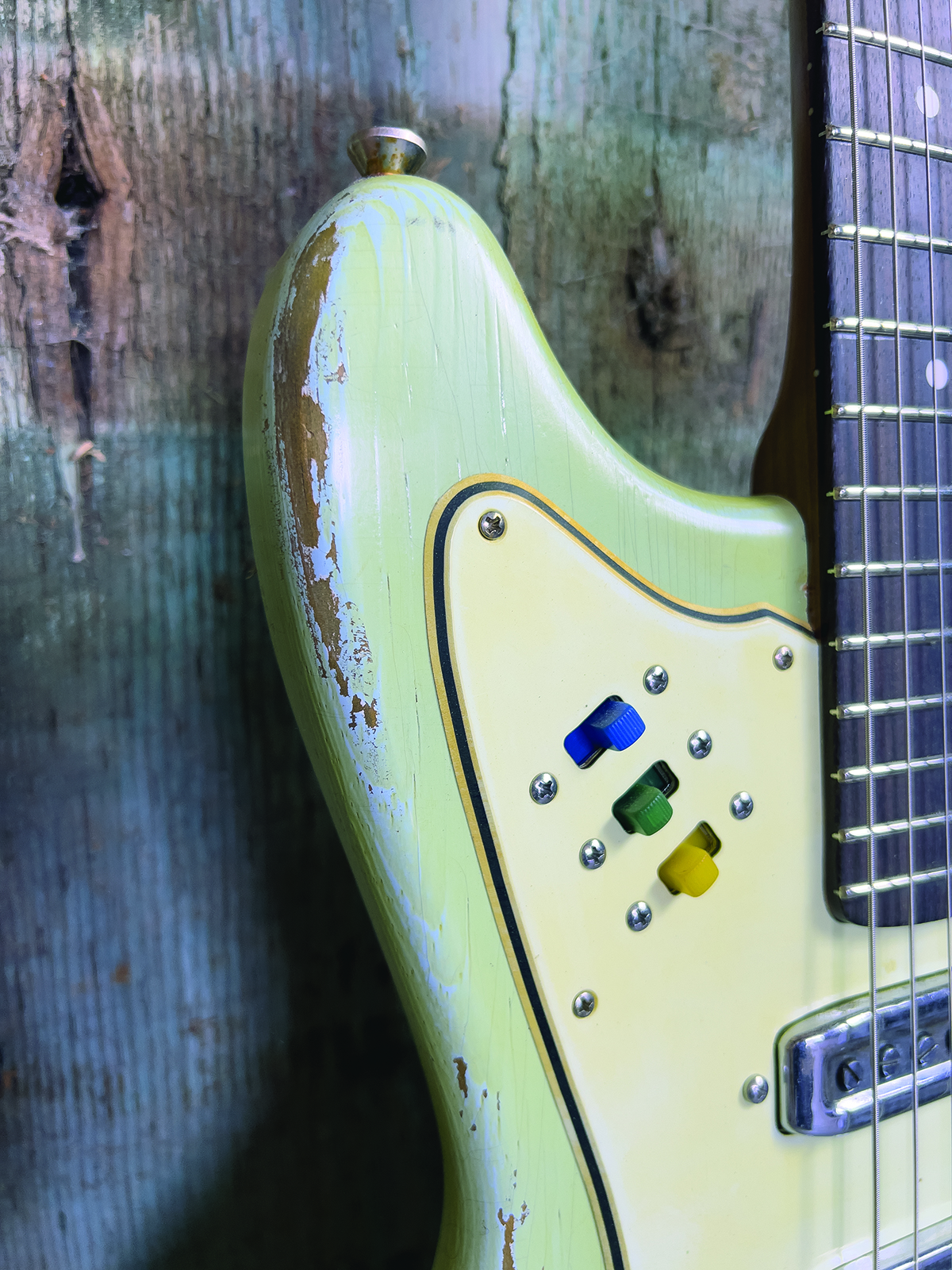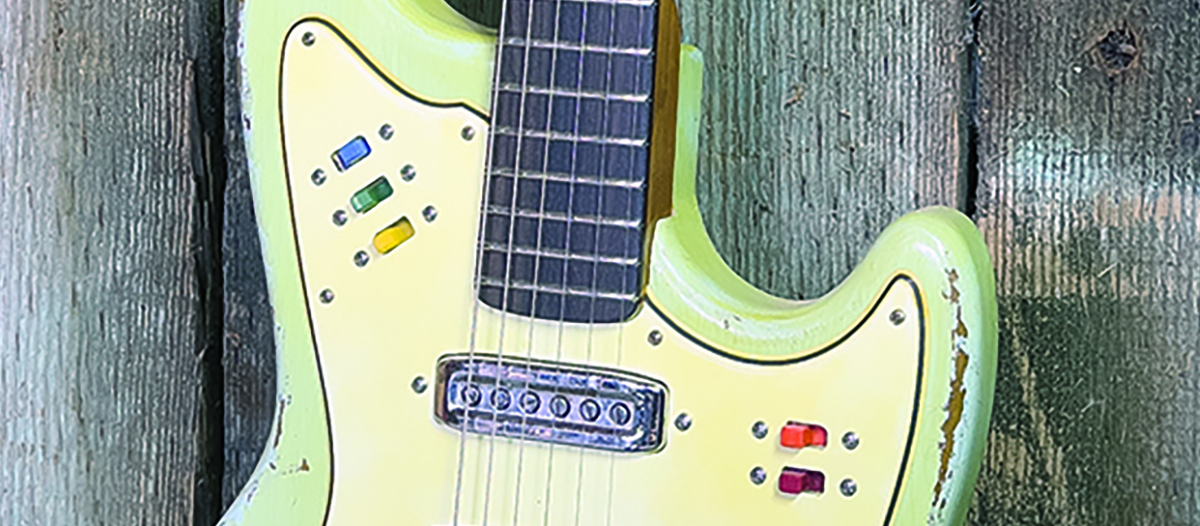GuitarPlayer Verdict
It looks like a funky Fender Jaguar by way of a 1960s Japanese manufacturer, but the sheer quality of the build and playing feel are evidence of its boutique origins. The neck has a beautifully rounded medium-C profile, and the rewound vintage Kawai pickups deliver an alt-rock-approved tone that will add a new and unparalleled voice to most guitarists' collections.
Pros
- +
Great vintage looks crafted by hand with meticulous care
- +
Wonderful rounded medium-C profile neck
- +
Chris Swope–designed vibrato and bridge delivers improved string tension
- +
The vintage rewound Kawai pickups are girthy, with a slightly gritty edge
Cons
- -
None
You can trust Guitar Player.
Somewhere between dissecting guitars as a teen and opening his own shop half a dozen years ago, Justin Abernethy has worked with several of the finest guitar makers in business today. All of that has inspired the Abernethy Sonic Empress THC, an electric guitar that reflects some of the most appealing trends of these offset-inspired times.
The guitar shown here is not just any example of Abernethy’s cornerstone model but one built specifically for that icon of offset-leaning indie/alt/Americana, Jeff Tweedy, who kindly let GP divert it on the journey from its birthplace in Guadalupe, California, to the Wilco loft in Chicago, for a quick run through its paces. Although the rather Mustang-like upper bout and more bulbous lower bout may suggest otherwise, the Sonic Empress THC is made to a full 25–inch scale length, with a
width of 1.65 inches across the bone nut and a 12-inch radius to the Indian rose-
wood board. The bolt-on neck is made from tempered (a.k.a. roasted) maple,
and the body is made from tempered pine. Its Sonic Blue nitrocellulose lacquer finish has greened up nicely due to the factory aging of the clear coat, with further character added by Abernethy’s own hand distressing.

Elements of the general look and build approach — from the tempered pine and maple to the pre-aged finish — remind me of Dennis Fano’s work under his own name in the past, and more recently via his Novo brand. As it happens, there are just a few degrees of separation between the two builders. After graduating from high school, Abernethy apprenticed in guitar repair at a local shop, then jumped at an opportunity to work for Gene Baker. Over a period of about 15 years he worked and built guitars for Baker, Ernie Ball, National Resophonic, Fine Tuned Instruments and Premier Builders Guild — which was headed by Baker and made Fano guitars under license — before starting up his one-man shop in the late 2010s. If anything, though, Abernethy takes the “alternative-vintage” premise even further with a combination of elements that never really appeared together on any one production model before, plus plenty of original touches.
Yet for all the Sonic Empress’s funky Jaguar-meets-Japanese-meets-catalog-grade-guitar looks and features, it’s the sheer quality and playing feel that grab you when you pick it up. The neck has a beautifully rounded medium-C profile that’s virtually impossible not to like, whatever your usual favorite, and everything is utterly solid and well-honed.

Even the quirkier elements in evidence here — the colored slider-switch tips, fluted vibrato-arm tip, clear radio knobs and clear buttons on the open-gear Grover Sta-Tite tuners — are hand molded in-house and accordingly exhibit a high degree of custom-building. And if those pickups look like something you’d find on Teisco and other budget-level Japanese creations from the ’60s, you’re not wrong. Abernethy sources what he can of these vintage Kawai-made pickups and has them rewound as necessary by his pal Rob Banta at Gemini Pickups in Newburgh, New York.
“This particular build is kind of unique, not a standard option—although they are
all kind of unique,” Abernethy tells us. “I hadn’t really planned to build another like this because of the work involved casting the colored sliders, but when the Tweedy camp requested it, I took it as a personal challenge. The Kawai pickups are sweet, and I use them as often as I can find them. Rob is a brilliant pickup designer and has made some really killer old sets magical by rebuilding damaged ones with vintage-correct wire and components. They’re like the best-sounding Strat set but with bigger cajones. Ever wonder what it would be like to take an old Model T and retrofit it with a 350 V-8? This is kind of the same concept.”

The slide switches include an on/off at the upper horn for each of the pickups. Two more sliders on the lower horn include a phase-reverse for when either the neck or bridge pickup is used with the middle pickup, and a low-cut filter reminiscent of the “strangle switch” on the Fender Jaguar.
All the latest guitar news, interviews, lessons, reviews, deals and more, direct to your inbox!
The most notable elements of the hardware set are the Descendant JM-style vibrato and Companion bridge, designed and manufactured by guitar maker Chris Swope. I reviewed these new designs in the Holiday 2022 issue and was impressed with how they improved string tension across the bridge, often a tone-eviscerating weak point of offset-style guitars. Abernethy agrees. “The Descendant trem and Companion bridge have become a staple on all my trem builds,” he says. “I love working with Chris, and the latest version of his trem is great. Plus, it’s a tad lighter than the Mastery, which makes a big difference when considering weight and the sum of all parts.”

Most observers will find plenty of noteworthy features at the other end of the guitar, too, where Abernethy’s headstock presents a style you don’t find on many electric guitars. “I’ve always loved the look of a slotted peg head,” he exclaims. “I think a lot of players are skeptical, being that their only experience with them is on an old classic guitar, but I think the stability on these is second to none. Plus, I’ve never seen anyone else utilize a one-inch quartersawn neck blank this way. I’m able
to get excellent downward pressure on the back of the nut without need for any string trees as well, so it’s kind of the best of both worlds between an angled and straight headstock.”
The Sonic Empress was a blast to test-drive through a 65amps London head and 2x12 cab, a tweed Deluxe-style 1x12 tube combo, and a Fractal FM9 into headphones. If the three single-coil pickups and access to in-between sounds makes you think “alt-Strat,” hold that thought. The pickups and switching combinations do yield incredible versatility and a wide range of voices, but the tones available are really quite unlike anything else. Think “Jaguar meets Jazzmaster meets mail-order guitar,” with the snarky edge of lower-wind pickups, a touch of gold-foil attitude, and plenty of depth and resonance imparted by the quality of the build, woods and hardware.

There’s tons of sparkle and shimmer from the bridge pickup, with no harshness.
I can see this being fantastic for recording sounds you’d expect to be getting from a Rickenbacker or any Fender offset, for example, but too often have trouble successfully achieving. While the pickups are a pretty low-output design, the end result is still surprisingly girthy, with a slightly gritty edge to the voice that adds texture and depth. Added to that, the Jaguar-style strangle switch was particularly sweet applied to the neck pickup, while the out-of-phase positions were very cool with a fuzz pedal engaged, eliciting a nasty, hairy scooped tone that’s great for funky psychedelic blues riffs.
To extend Abernethy’s car metaphor, the Sonic Empress is something of a Ferrari disguised as a Nissan Figaro, and tons of fun by any measure. Let's just say sending this guitar back on its journey to its owner wasn't easy.
CONTACT abernethyguitars.com
PRICE Starting at $4,200 direct
Dave Hunter is a writer and consulting editor for Guitar Player magazine. His prolific output as author includes Fender 75 Years, The Guitar Amp Handbook, The British Amp Invasion, Ultimate Star Guitars, Guitar Effects Pedals, The Guitar Pickup Handbook, The Fender Telecaster and several other titles. Hunter is a former editor of The Guitar Magazine (UK), and a contributor to Vintage Guitar, Premier Guitar, The Connoisseur and other publications. A contributing essayist to the United States Library of Congress National Recording Preservation Board’s Permanent Archive, he lives in Kittery, ME, with his wife and their two children and fronts the bands A Different Engine and The Stereo Field.


